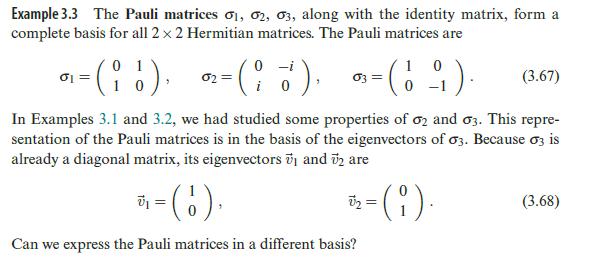In this exercise, we study the unitary matrix constructed from exponentiation of one of the Pauli matrices,
Question:
In this exercise, we study the unitary matrix constructed from exponentiation of one of the Pauli matrices, introduced in Example 3.3. As Hermitian matrices, exponentiation should produce a unitary matrix, and we will verify that here.
(a) As Hermitian matrices, the Pauli matrices can be exponentiated to construct a corresponding unitary matrix. Let's exponentiate \(\sigma_{3}\) as defined in Eq. (3.67) to construct the matrix
\[\begin{equation*}\mathbb{A}=e^{i \phi \sigma_{3}} \tag{3.150}\end{equation*}\]
where \(\phi\) is a real number. What is the resulting matrix \(\mathbb{A}\) ? Write it in standard \(2 \times 2\) form. Is it actually unitary? Remember that exponentiation of a matrix is defined by its Taylor expansion.
(b) Now, consider the Hermitian matrix constructed from the sum of \(\sigma_{1}\) and \(\sigma_{3}:\)
\[\sigma_{1}+\sigma_{3}=\left(\begin{array}{cc}1 & 1 \tag{3.151}\\1 & -1\end{array}\right)\]
Exponentiate this matrix to construct \(\mathbb{B}\), where \[\begin{equation*}\mathbb{B}=e^{i \phi\left(\sigma_{1}+\sigma_{3}\right)} \tag{3.152}\end{equation*}\]
Can you express the result in the form of a \(2 \times 2\) matrix?
Taylor expand the exponential function and sum up the terms with even powers of \(\phi\) and odd powers of \(\phi\) separately.
Example 3.3.

Step by Step Answer:

Quantum Mechanics A Mathematical Introduction
ISBN: 9781009100502
1st Edition
Authors: Andrew J. Larkoski





